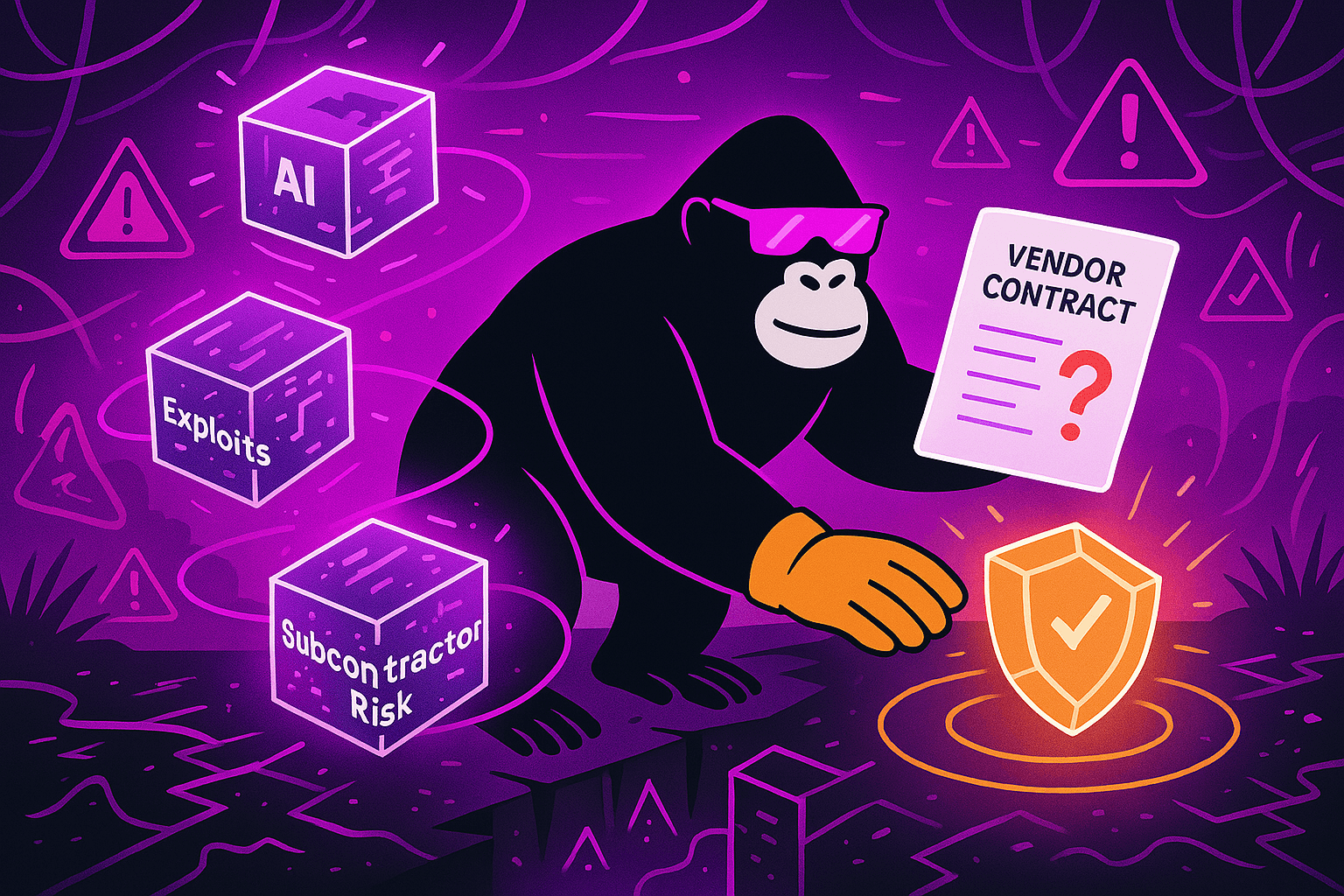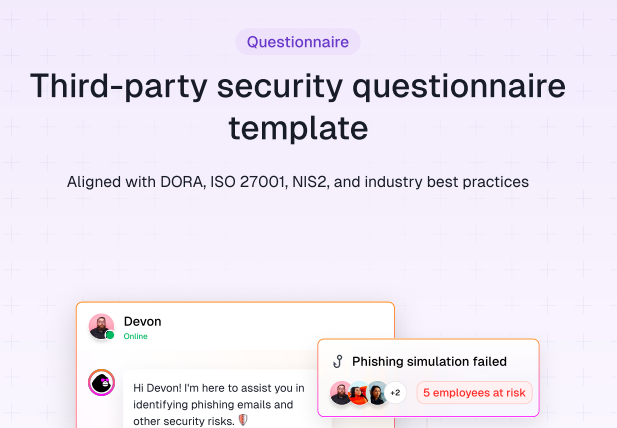The increasing reliance on third-party vendors to manage critical operations has redefined how organizations approach cybersecurity and risk management. In 2025, vendor security and risk assessment questionnaires are no longer optional—they’re essential tools for protecting sensitive data, ensuring regulatory compliance, and maintaining trust with stakeholders.
A single vendor’s weak security posture can expose your organization to breaches, reputational damage, and regulatory fines. A recent report from the Ponemon Institute reveals that 54% of organizations experienced data breaches resulting from third-party incidents. With threats such as ransomware attacks and AI-driven exploits on the rise, organizations must scrutinize vendors more thoroughly than ever.
This guide will explore why these questionnaires matter, how to design an effective one, and how automation tools can streamline the process while keeping your organization ahead of emerging risks.
Why Vendor Security Questionnaires Are Critical in 2025
Your organization is only as secure as its weakest link. With vendors becoming extensions of your operations, this statement is more relevant than ever. Consider the infamous Target breach of 2013, which was traced back to a third-party HVAC vendor. It serves as a stark reminder: no matter how robust your internal defenses are, a vendor’s vulnerabilities can have a direct impact on your organization.
The cybersecurity landscape is increasingly interconnected, with vendors managing sensitive data and critical systems across industries. Regulatory frameworks like GDPR, HIPAA, and the Digital Operational Resilience Act (DORA) now mandate active third-party risk assessments.
A comprehensive security questionnaire for vendors offers several key benefits:
- Identifying security gaps: Spotting vulnerabilities in vendor processes before contracts are signed.
- Ensuring compliance: Demonstrating adherence to evolving regulatory requirements.
- Driving accountability: Encouraging vendors to prioritize and strengthen their own security measures.
However, achieving these results requires questionnaires that are not only well-designed but also efficient and easy to maintain.
PRO TIP
Create a centralized “Questionnaire Registry” in your GRC platform or spreadsheet that tracks each vendor’s latest completed questionnaire, version number, and review date. This single source of truth prevents duplicate requests and ensures you always reference the most up-to-date risk data.
Designing a vendor security assessment questionnaire that delivers results
A poorly designed vendor security assessment questionnaire can do more harm than good. It wastes time, creates confusion, and fails to provide actionable insights. To avoid these pitfalls, focus on tailoring your questionnaire to assess the risks most relevant to your industry and operations.
What should the questionnaire cover?
A strong vendor security questionnaire focuses on three pillars: organizational security policies, technical safeguards, and incident response capabilities. Here are key areas to address:
| Category | Key question |
| Data security practices | How does the vendor store, encrypt, and manage sensitive data? |
| Access management | What controls are in place to manage access to systems, such as multi-factor authentication (MFA)? |
| Compliance | Does the vendor meet industry standards like ISO 27001, SOC 2, or local regulatory requirements? |
| Incident response | How does the vendor identify, respond to, and recover from security breaches? |
| Vendor oversight | Does the vendor rely on subcontractors, and if so, how are they vetted for compliance? |
For example, instead of asking a generic question like, “Do you have an incident response plan?” request a specific example: “Describe the frequency and scope of your incident response plan testing.”
Get a free third-party security questionnaire template!
Avoiding common mistakes
One common mistake is overloading the questionnaire with too many technical or irrelevant questions. Vendors may struggle to respond effectively, leading to incomplete or unusable answers. To address this, keep your questions concise and focused on practical insights.
Another challenge is failing to communicate the purpose behind the questionnaire. Explaining how their responses will influence risk management fosters collaboration and trust.
PRO TIP
Include a “Purpose Statement” at the top of your questionnaire that explains why each section matters (e.g., “Section 3: Access Management ensures only authorised users can view your data”). Context boosts the completeness and accuracy of vendor responses.
Streamlining the process with automation
Despite their importance, security questionnaires are notoriously time-consuming. A single questionnaire can include over 100 questions, and organizations often manage multiple questionnaires at the same time. This can overwhelm even the most experienced teams.
Platforms like CyberUpgrade offer an easy solution by automating the security questionnaire process. Here’s how it works:
| Step | Description |
| Upload previous questionnaires | Start by uploading completed questionnaires in Excel format. |
| AI learns your processes | The platform analyzes past answers and builds a knowledge base of your organization’s security protocols and compliance measures. |
| Automate answer generation | For new questionnaires, CyberUpgrade generates responses automatically, which can be reviewed, edited, and approved with minimal effort. |
| Continuous learning | The tool refines its knowledge base as more questionnaires are completed, ensuring greater accuracy and efficiency over time. |
By automating up to 90% of the questionnaire process, CyberUpgrade significantly reduces manual effort, ensuring consistent and compliant responses while freeing up your team for higher-priority tasks.
Best practices for automation
Automation is a powerful tool, but it is most effective when combined with human oversight.
Ensure that:
- Responses are reviewed carefully to avoid errors or misinterpretations.
- The knowledge base is updated regularly to reflect new security practices or policies.
- Automation tools are aligned with compliance frameworks like NIST and ISO 27001 for greater accuracy.
Before you start automating, creating a fail-proof template for security questionnaires is important. In the table below, we provide pointers on what good questionnaires should include:
| Section | Example questions |
| General information | – What services do you provide, and how do they support our operations? |
| – What certifications or compliance standards (e.g., ISO 27001, SOC 2) do you hold? | |
| Data protection | – How do you encrypt data at rest and in transit? |
| – Do you conduct regular vulnerability assessments on your data storage systems? | |
| Access management | – How do you ensure secure access to systems handling sensitive data? |
| – Are role-based access controls (RBAC) and multi-factor authentication (MFA) implemented? | |
| Incident response | – How do you notify clients in the event of a data breach? |
| – Have you conducted a security incident simulation within the past year? | |
| Vendor oversight | – Do you subcontract any services? If so, how are subcontractors vetted and monitored for compliance? |
| – What processes do you use to ensure your vendors meet industry security standards? |
This template balances depth and usability, ensuring you collect actionable insights while respecting vendors’ time.
PRO TIP
Schedule a monthly “Answer quality audit” where your security team reviews a random sample of AI-generated responses against source evidence. This spot-check cycle ensures the tool’s knowledge base stays aligned with your evolving policies.
Adapting to emerging risks and threats
The cyber threat landscape is evolving rapidly, with risks like ransomware targeting supply chains, AI-driven phishing attacks, and zero-day vulnerabilities. To stay ahead, your vendor security questionnaires must adapt. Here are practical steps to ensure they remain relevant:
| Focus area | Actionable advice |
| Update regularly | Review and update questionnaires annually to include questions about emerging threats, such as ransomware and AI risks. |
| Incident response | Ask how vendors test recovery plans and simulate attacks: “How often do you conduct ransomware drills?” |
| Subcontractor oversight | Assess how vendors monitor third parties: “How do you ensure subcontractor compliance with security standards?” |
| Continuous monitoring | Schedule quarterly check-ins to track vendor updates and risk changes. |
| Automate for efficiency | Use automation to generate follow-up questionnaires and flag incomplete or inconsistent responses. |
By focusing on these steps, your organization can adapt its assessments to address new threats, reduce risks, and maintain strong vendor oversight.
Searching for a third-party risk management solution?
VendorGuard ensures seamless DORA compliance.


Automate vendor security questionnaires with CyberUpgrade
Manual questionnaires often become outdated and overwhelming, leaving hidden risks unaddressed as threats evolve. CyberUpgrade streamlines the process by automating question generation, version tracking, and response collection via real-time Slack or Teams prompts. This reduces time spent on repetitive tasks while ensuring assessments stay aligned with emerging threats and regulations. Centralized storage of responses keeps your audit readiness transparent and up to date.
Continuous updates are crucial as vendor environments change. CyberUpgrade’s automation flags when new questionnaire items—such as AI-driven risk or ransomware readiness—should be added and gathers evidence automatically. Real-time alerts notify you of incomplete or inconsistent answers, enabling prompt follow-up without manual chasing. This approach maintains a living questionnaire registry that reflects the latest security practices.
Expert guidance shapes your questionnaire templates and review workflows without needing a full-time specialist. Fractional CISO support tailors the assessment scope to your industry and risk appetite, ensuring compliance with GDPR, HIPAA, DORA, or other standards. By automating up to 90% of questionnaire tasks, CyberUpgrade frees your team to focus on remediation and strategic vendor collaboration. Continuous, automated assessments build confidence in your third-party ecosystem before issues materialize.
Looking ahead: building a resilient vendor ecosystem
In 2025, vendor security questionnaires are not just a compliance requirement—they are a cornerstone of modern risk management. By designing focused, actionable assessments and regularly updating them to address emerging threats, you can safeguard your organization while building trust with your vendors.
As cybersecurity threats evolve, consider integrating new technologies like AI-driven assessments or real-time monitoring platforms to enhance your vendor evaluation process. Are your current strategies enough to keep pace with this dynamic landscape?
It’s time to rethink how you evaluate third-party risks and take proactive steps to build a resilient vendor ecosystem.










